Sydney Eat Street: What do eat at Darling Square in Haymarket
Flavour meets spectacle at this exciting new precinct on the edge of the CBD where the eateries are now happily buzzing once again. Darling Square in Haymarket has loads of food options on offer. TAKE A LOOK
Eat Street
Don't miss out on the headlines from Eat Street. Followed categories will be added to My News.
- Places that diners are flocking to after lockdown
- New eateries finally open for business after lockdown
Carefully selected for their unique and authentic menu, the collection of eateries at Darling Square, Sydney’s newest neighbourhood, represents some of the best foods Australia has to offer.
The Sunday Telegraph’s Sydney Eat Street keeps you up-to-date on what’s happening in the food industry and where Sydney’s best eateries are. Are you hungry for more inspiration? Follow us on Instagram. #SydneyEatStreet
XOPP BY GOLDEN CENTURY
Located on the mezzanine level of The Exchange, a six-storey building wrapped in 20km of curved timber, XOPP is named after its sister restaurant, Golden Century’s signature dish XO pipis – wok-fried pipis in XO sauce.
It’s been a menu standout for more than 30 years, loved equally by everyday diners and the culinary elite (David Chang of Michelin-starred Momofuku Ko calls it “the best dish in the world”) so it only goes to reason that it would be the inspiration for the Golden Century Group’s latest restaurant.


“The flavours are familiar and you’ll recognise the dishes when they come out but they’re a bit more playful,” restaurateur Billy Wong, son of Golden Century owners Eric and Linda Wong, says.
“If we had called it Golden Century, people would just come here expecting the same thing. But being so close to the original restaurant (in Haymarket) and this being a new precinct, it was never going to be another Golden Century, but we also wanted to give it a name that people could associate with it (Golden Century).
“The name XOPP is a bit of fun. If you get it, you get it. It’s like you’re in on something and if you’re not, you’re curious.”


Billy is eluding to the not-so-secret success of the iconic dish which his parents introduced to Sydneysiders when they first came to Australia from Hong Kong in 1989.
“When we first started doing pipis, they were just another clam and it was inexpensive as people could just get it off the beach (30 years ago) so, by cooking pipis in XO sauce, it was combining very affordable seafood that you could get fresh at any time with an expensive sauce,” he says.
Since XO first appeared on the menu, the recipe for the more-ish sauce has remained unchanged. To explain its allure, Billy notes that while the list of ingredients is basically the same everywhere, all chefs, including those under the Golden Century banner, will have their own recipe but that the most important (and most expensive) ingredient is the dried scallop.
“In Hong Kong, people relate to XO as something that is always premium, something that people always aspired to like XO Cognac becoming a go-to drink. And since XO sauce originated in Hong Kong with premium ingredients, when they see XO, they know it’s going to be great,” Billy says.

Head up the wraparound stairs of the “hive”, to the entrance where the neon XOPP sign hints as to what awaits inside.
The X and O are written in calligraphy which Billy says speaks to the long period of tradition and culture behind the Cantonese cuisine, while the P’s are clean, sleek and very modern.
They also reflect the architectural structure of the building.
“Together, it signifies the merge between old and new.”
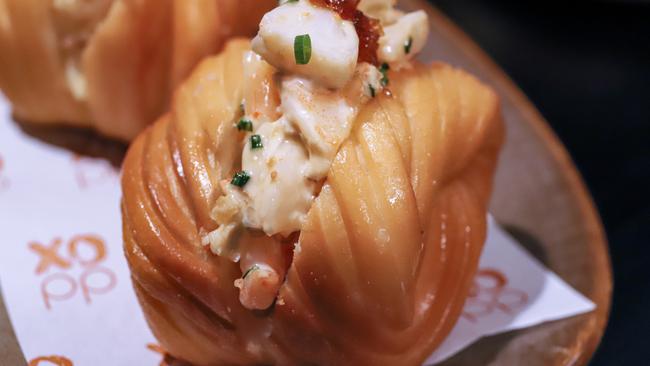
Open the doors and you’re welcomed by a chic backlit bar that serves what they refer to as “snacks” such as the XOPP prawn mantou roll and duck and shallot cheese pancake but are more clever petite previews of the restaurant’s main menu.
In the dining area, a pale sea foam green is punctuated by playful orange chopsticks and glasses.
Popular choices are the Peking duck pancakes, kung pao cod fillets and of course, the main act, 500g of pipis, wok-fried in their secret XO sauce and served atop of a bed of dried vermicelli that graciously soaks up the glorious sauce creating soft tasty noodles.
— The Exchange, Mezzanine Level, 31/1 Little Pier St, Haymarket; xopp.com.au
IIKO MAZESOBA
It’s all out in plain sight at this relatively new addition to the global ramen scene. Unlike other ramen bowls that are filled with broth, Mazesoba dry version replaces soup with a concentrated sauce at the bottom so, as owner Michelle Widjaja notes “every ingredient has to be super fresh as there is nowhere in the bowl to hide”.
It’s something that appealed to her while she was running her cafe in Indonesia, before Mazesoba outlets began popping up nearby.
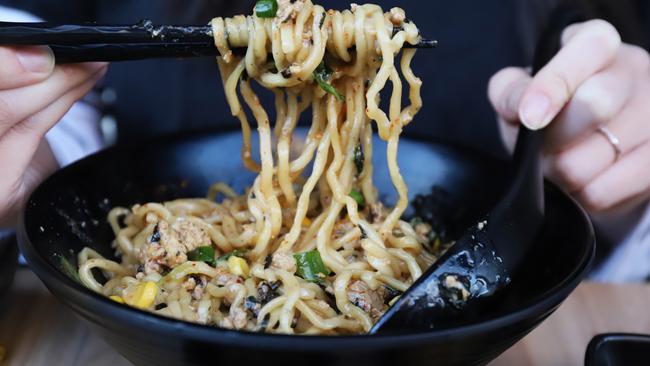
A trip to Tokyo changed that though and she recognised a potential market for it in Sydney.
“Shops are small in Japan so you can’t have a large menu; you have to specialise,” she says.
With that, Michelle undertook a two-week intensive course, learning how to make all kinds of ramen but opted to focus on the dry version in that “it really lets the ingredients speak for themselves”.
Compared to soup ramens with thin noodles, which are great for slurping but not quite conducive to tidiness, Mazesoba noodles are thicker which because it is broth-less which gives them more surface area to hold the sauce, which sits at the base of the bowl beneath the noodles and other ingredients.
While you’re free to enjoy the dish anyway you choose, Michelle explains that the flavours are best experienced when the whole dish is mixed together, starting off with two swirls each of chilli oil and vinegar, crack the Onsen egg, mixing it from the bottom up, blending all the layers of flavours.
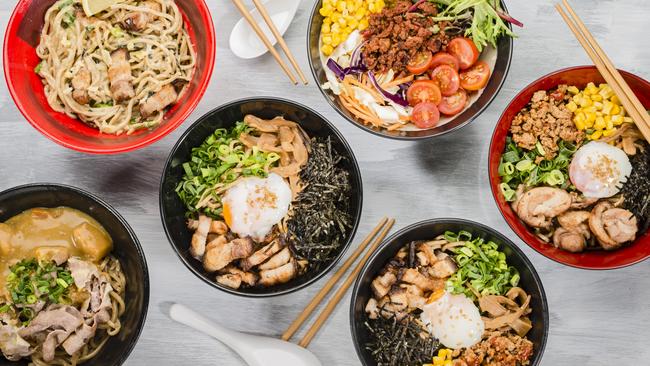
The menu is relatively small but mighty. The tender karaage chicken is a popular choice as is the Zenbu Mazesoba, a version made with pork chashu and spicy pork mince which started off as a “secret dish” but quickly made regular rotation.
There is also a vegan option with sauteed mushrooms, roasted tomatoes.
“Non-vegans really like it too. They just add an egg on top,” Michelle says.
While this dry, soup-less ramen version is still a relatively new concept, Michelle notes that Mazesoba’s Sydney debut has been made easier thanks to the Darling Square precinct.
“We’re all here for each other and were given lots of support,” she says, adding it’s wonderful being a dog-friendly precinct.
— 86 Hay St, Haymarket; mazesoba.com.au
KÜRTOSH
While Paris may be the city of romance, it was on a side street in Hungary that Ben Haikin found his match — a street vendor selling Kürtosh, hot chimney cakes made by wrapping a thick rope of dough around a cylinder, basting it in butter and sugar roasting it on a spit over cinders.
“I was wowed by it. I fell in love with the whole experience,” says Ben.
“Not just the sweet baked sugar flavour, but also the soft dough and crunchy outside.”
Watching as the dough turned a golden brown and then was pulled from its mould to resemble a smoking chimney, “what a show”.
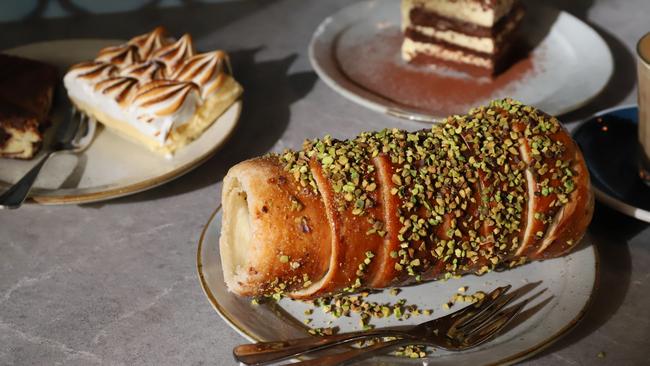
Ben knew he had to bring the concept to Australia and along with brother Tom and pastry chef Jean-Marc Masset, they sourced the equipment and more importantly, the 120-year-old recipe and began production in Randwick.
While the cafes carry the dessert’s name, it wasn’t necessarily the inspiration for the venture; that honour goes to their grandmother the family bakery back in Israel.
“It’s the smell of freshly baked cakes. It just overwhelms the senses. I wanted to bring back those childhood memories,” says Ben.

At Kürtosh, Ben still uses his grandmother’s cake recipes and still sells them the way she did – by weight.
“This way you can have as little or as much as you want,” he says.
Add to that a great cup of coffee, which, thankfully they offer throughout the day and not just until 3pm and you’ve set yourself for some me-time.
“A slice of cake and coffee, whether you’re by yourself, on a date or out with friends, always make for a happy moment.”
— Shop 2/16 Nicolle Walk, Haymarket; kurtosh.com.au
AUVERS
If you know art when you see it, you’ll be perfectly at home here at Auvers, sipping coffee or cocktails surrounded by vibrant murals, sleek architectural lines and creative touches that every aspect of this warm and welcoming restaurant.
Named after Auvers-sur-Oise, the resting place of renowned painter Vincent van Gogh, owners Leo Rong and Kim Bong work under the ethos that “art inspires” which is reflected in everything from their French and Asian fusion cuisine, to their clever Impressionistic themed cocktails (Starry 75) and the bespoke crockery well suited to latte art.
“It’s part of our everyday life.”

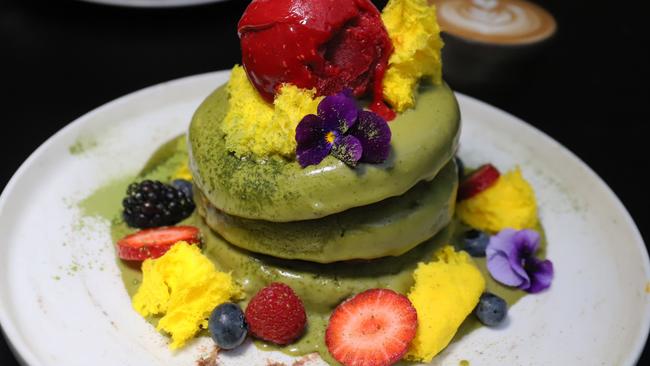
Here, the food is appealing to the eye as it is the belly such as with the XO Seafood spaghetti with squid ink linguine and pipis or the Sydney. Rock Oysters Mignonette.
Brunch is equally Instagrammable – the Auvers pancakes are bright a bright matcha green with red bean paste, matcha glaze and raspberry sorbet.

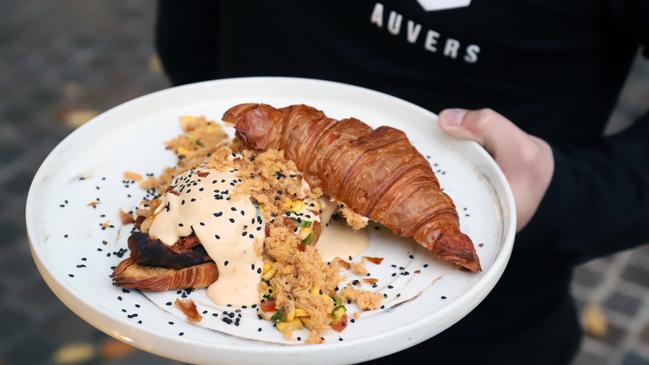
Equally stunning and truly clever is the Auvers’ eggs Benedict – smoky pulled pork, runny Onsen eggs, smoky ponzu hollandaise, spinach, corn salsa, pork floss on a toasted croissant.
Day or night, with this menu, Auvers will have you writing love songs to the gods of herbs and spices in no time.
— Shop 4, 12 Nicolle Walk, Haymarket; auverscafe.com.au
CHINTA RIA: BUDDHA LOVE
All you need is love. Love is all you need. And maybe a plate of chilli crab. And some XO fried rice.
After a long absence the big belly Buddha that once sat pride of place at Chinta Ria: Temple of Love in Darling Harbour, has returned this time to Darling Square, thanks to his gregarious minder, renowned restaurateur, Simon Goh.
It’s the latest recantation Simon has also brought back some of the much-loved Malaysian dishes including the coveted chilli crab with man tau and crispy noodles.
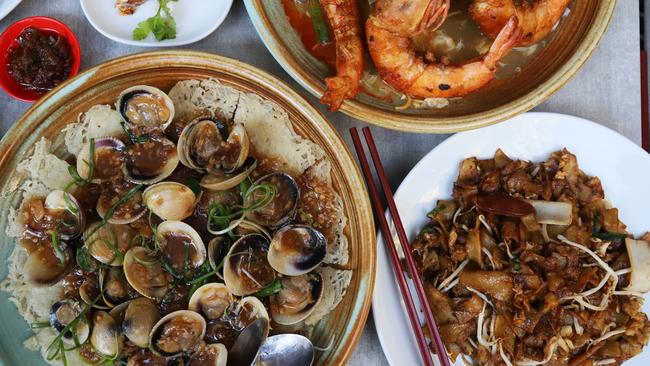
As tempting as it may be to linger on one dish, share the love and order other favourites, including the Royal Prawns – crispy noodles embraced by king prawns in ginger and shallot gravy or the char kway teow – satisfying wok-fried flat rice noodles with Chinese sausage and chives.
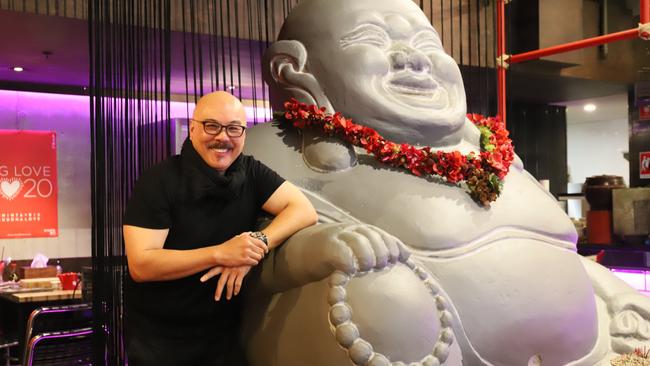
And of course there has to be a side of XO fried rice with shrimp and crabmeat.
“Chinta means love and Ria means happiness,” Simon says.
“I want people to feel loved when they come in and happy when they leave.”
Judging by the people waddling out, rubbing their bellies after a filling dinner, looks like mission accomplished,
— 14 Nicolle Walk, Haymarket; chintariabuddhalove.com
NAKANO DARLING
Pub culture. While a chicken schnitty and a tinnie may not exactly translate but every country the world over has its own take on what makes for a great place to hang out after work with colleagues or evenings with friends.
In Japan, those places are called izakayas which as Chris Wu, co-owner of Nakano Darling, helps to explain, and it’s where you sort of have an eat-drink-talk cycle that can go on for hours and is ideally, a bit chaotic in nature though there are quieter settings to be had.
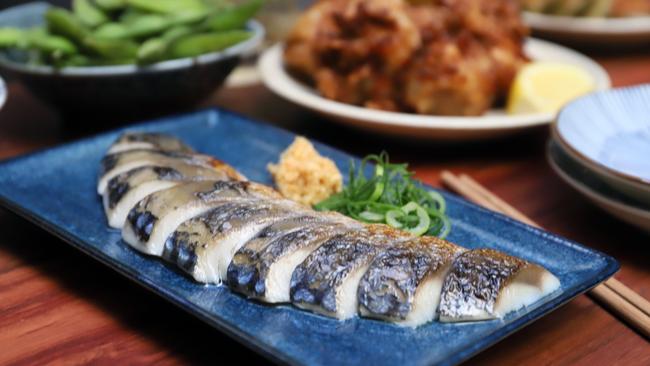

At Nakano Darling, he suggests starting off with a plate of the ever-popular karaage chicken and gyoza along with their signature drink, the Highball or what he says is often referred to as the “salaryman drink” which loosely translates to a businessman’s drink and is made specifically with Suntory whisky as “it’s more flavoursome”.
In Japan, Chris notes that weeknights will often be filled with office workers.
“It’s a way of businesspeople getting to know each other by sharing food,” Chris says but that the weekends tend to be more relaxed with friends and families.
And, here’s something to note, in an izakaya, don’t expect to be doted on by the waitstaff, this isn’t to say that they’re indifferent just that it’s considered polite and proper to let people sit without interference.

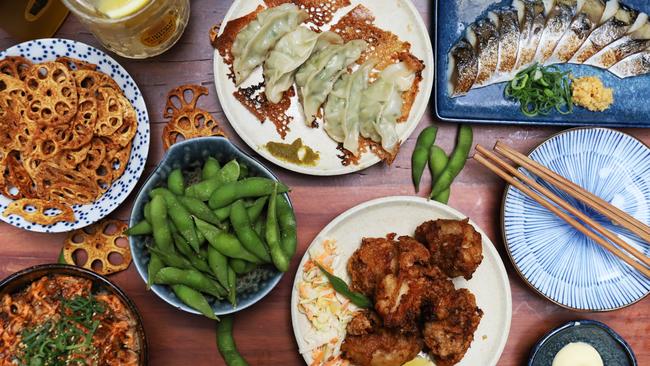
So, when you’re ready for that next drink or more vinegared mackerel, lotus root chips or even one of the more substantial hot dishes such as fried udon with pork slices, just raise your hand.
And if it’s too daunting remembering the details, fear not, they’ve put some tongue in cheek instructions up out front on the door.
— 14 Steam Mill Lane; nakanodarling.com.au
HAKATA-MARU RAMEN
Before Market City’s upper level renovation brought in more contemporary eateries, there were still some real gems to be found in that tired old food court, one of which was Hakata-Maru Ramen.
And though owner Hide Tsuboi was resigned to saying goodbye to an era, his customers weren’t quite so accepting.
“We kept getting messages saying we miss you and asking when we’d be back,” Hide says.



While he was offered a premium spot in the main food court, he turned it down — one reason being that he’d have to use take-away bowls rather than the proper ceramics ones that retain heat.
Fortunately, a spot opened in Darling Square and fans were once again able to get their Hakata-style ramen (thin and straight noodles served al dente) in pork bone broth.
It’s delicious but it’s also a very labour intensive 36-hour process that alternates soaking and high-heat simmers to break it down to a milky colour and consistency.

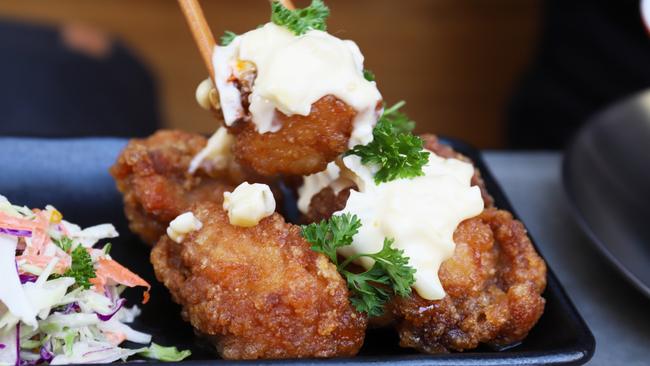
You can go solo with a bowl all your own, but that means you’ll fill up and miss out on other menu items including yummy miso-based ramen with “frizz” noodles as well as side dishes of gyoza and karaage chicken. In that case Hide suggests ordering a few sides and sharing a bowl of the tonkotsu ramen with chashu pork and ordering an extra side or two of noodles ($2) to add to the soup as you go.
— 6/8 Nicolle Walk; facebook.com/hakatamarudarlingsquare/
MR BAO
True love can be so inspiring, or in the case of James Pham and Angelina Lee, it was technically their anniversary dinner at David Chang’s Momofuku Seibo that proved inspirational as once Chang’s famous pork buns were served, what had started what started off as a romantic evening would be the impetus for their future venture.
Although James was working as a lawyer at the time, he had grown up in his parents’ bakery in Cabramatta and always considered getting back into food.
Those buns were the nudge he needed and together with Angelina they gave it a go, starting with a stall at Bondi markets.

First out of the fryer and into the bun was to be their signature item – the crackling pork belly bao with hoisin sauce.
“Adding crackling to the pork belly bun was our touch,” says James as he explains his approach of using its texture to contrast with the pillow-soft buns.
“Plus, who doesn’t love crackling.”
Turns out, he was right. People do indeed love crackling, all except his mother, who was now spending her weekends roasting pork.
The markets though, proved there was, well, a market for bao, so they expanded their range to include crispy tofu, and karaage chicken with spicy aioli, pickled red cabbage and coriander.
“The secret to our karaage chicken is that it is triple-fried,” James says, explaining that helps keep the meat nice and juicy.

You can still find them at the Bondi Markets on Saturdays and special events throughout the year, but when those cravings for a crackling pork belly bao can’t wait, that’s when a trip to their Darling Square outlet is in order.
While you’re there, try some of their newer offerings as well, such as Korean beef, char siu bao and the just-released dessert range that includes that crème brulee bao.
Deep-fried bun dusted with cinnamon sugar, vanilla bean ice cream and caramel sauce.
Wash that down with some freshly-made sugarcane and mint juice, and you’re all set till that next craving – or lunch – hits.
— Maker’s Dozen; Shop 7/1 Little Pier St; mrbaobuns.com.au
HAVEN SPECIALTY COFFEE
You know the old adage: “If you love what you do, you’ll never work a day in your life.”
Clearly, that was written by someone with inherited wealth but for Herman Chiu, Haven’s co-owner there is merit in the saying.
“I was working in advertising, but I really wanted something that required craftsmanship,” Herman says, and so the lifeforce of the working world became his calling.
Along with his business partner Kit Tran, they first opened Haven as a cafe in Surry Hills four years ago.
“That location is more food-centric,” he says, whereas given the limited space and the foot traffic, the Darling Square location enables Herman to focus on coffee – making it, talking about it, teaching it.
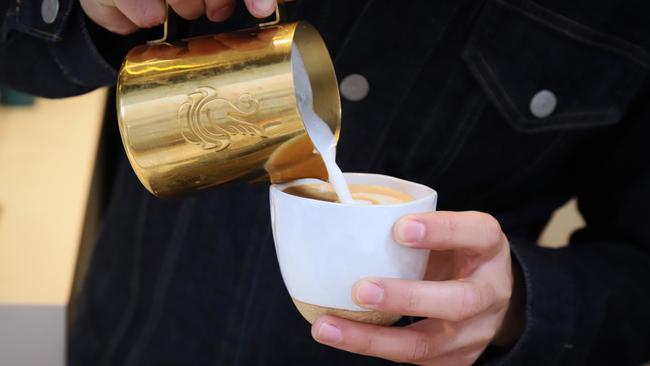
At the moment, their formal coffee appreciation and latte art workshops are held in Surry Hills; still, he’s happy passing out tips and tricks from behind the counter – such as the proper temperature for drinking filtered coffee.
That’s a trick question actually, as Herman will tell you the taste changes as it turns from hot to cold. So the answer is “D – all of the above”.
Herman can also regale you with the qualities and properties of different beans, mainly because he is so particular about the ones they use at Haven seeing as they select and roast it themselves rather than having it created for them.

“It just gives us so much more quality control,” he says which allows more time to focus on other parts of the coffee-experience which includes everything from the clever fit-out with a few built-in tables to the lovely white-washed crockery which looks even prettier with Herman’s precise latte art.
True to form, Herman is generous with some pointers.
“Full cream milk is the best as the protein holds onto the air,” he says, adding that once you master the basic heart and rosetta, the rest is just a combination of the two.
So when you’re ready to sit down and enjoy a cuppa, have a look at the design atop your flat white and compare it to their logo. That’s no anchor you see, rather an aerated map to your safe haven.
— 85 Harbour St; havenspecialtycoffee.com.au
EDITION COFFEE ROASTERS
Goodbye rustic-chic, see ya later exposed brick and toodle-oo bric-a-brac. Having been part of Sydney’s cafe scene since 2005 (Edition Darlinghurst, Clipper, Room 10), Daniel Jackson has seen them all, but it was a trip to Japan that brought clarity.
“I saw the use of minimalism and started asking myself ‘Why can’t cafes be more refined? Why not have nice fit-outs? Why do they have to be fussy?”
At the time, he and his brother Corie Sutherland had Edition in Darlinghurst which already reflected their appreciation for Japanese and Scandinavia themes in both the menu and clean white interior.

To Daniel though, Darling Square needed to be different, starting with the interior which posed a problem with its recessed floors.
Instead of rising to the occasion, he lowered the tables, similar to a horigotatsu, a type of traditional Japanese table that’s low to the ground and has a recessed floor beneath it.
It was quite a practical solution and, falls in line with Daniel’s “think differently” approach.
Same goes for the menu which rather than being cookie-cutter, features “fine-dining techniques in a cafe environment”.
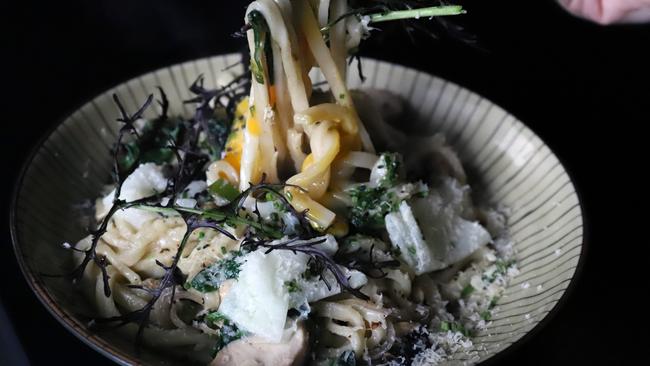
There is no dish on the menu that better exemplifies this message than the signature Japanese souffle pancake.
“There a 20-minute wait as they’re made from scratch,” he says adding that at any point there is always a second one in waiting as soufflés are notoriously temperamental.
This dish is always on the menu though the fillings and flavours change seasonally. At the moment, it’s an Earl Grey mousse with an apricot centre, beautifully presented on a stark black plate topped with dehydrated raspberries and micro-herbs.
It looks quite decadent, like it’d be quite heavy and dense, but take a bite and its texture is as light as butterfly kisses. Take a second bite just to make sure your brain is registering this juxtaposition.
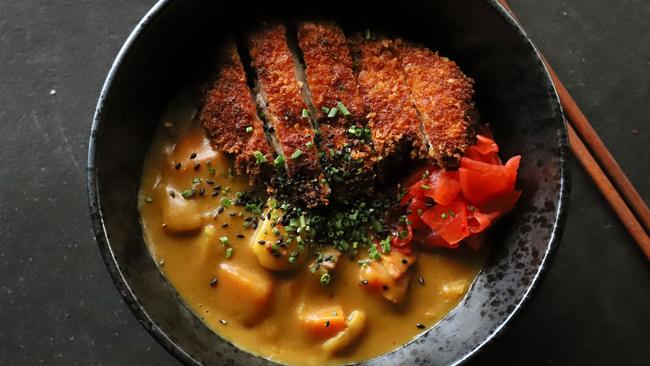
For those after something a bit more savoury the pork katsu curry with rice a real winter-warmer or the udon with mushroom, Onsen egg and chunks of soy, ginger, and cooking-sake poached chicken that just melts in your mouth.
Daniel has an equally particular approach to Edition’s coffee – be it espresso-based or filtered he avoids blends as he wants people to be able to taste its place of origin, such as the blueberries from Ethiopia or the orange flavours from Kenya.
Be it the food or the coffee, at Edition Daniel makes sure that in each, “the hero ingredient needs to be able to stand on its own”.
At the moment though, the true hero is willpower as it takes every ounce of it not to devour another Japanese pancake.
— 60 Darling Dr; editioncoffeeroasters.com
DOPA BY DEVON
Last year, the gents behind Devon Cafe opened the feel-good spot of the year, DOPA by Devon.
It’s their take on donburi dishes (“don” meaning bowl) and desserts found on the streets of Tokyo. In true Devon form, presentation is key and is surpassed only by quality and taste.
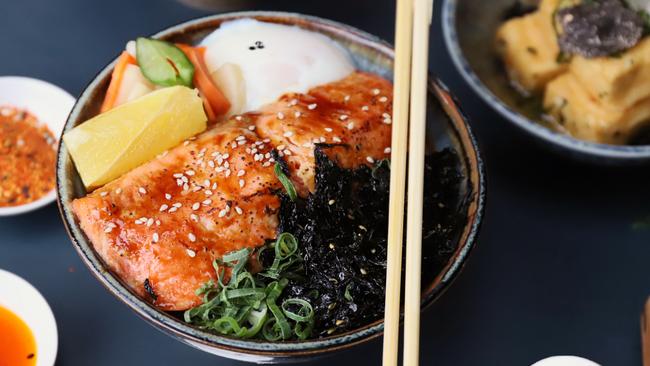

There’s the meticulously presented grilled salmon don which is a bowl of rice topped with King Salmon, saikyo miso and soft egg or the wagyu don with one of two different grades of beef – Wagyu (MS 6-7) or (MS 9+) with a soft egg.
Not to be outdone, nor overshadowed, there is the strawberry Kakigori dessert – a football-sized mound of shaved ice with strawberry gelato – in a bowl of course.
— Shop 5-6, 2 Little Hay St; facebook.com/dopabydevon/

